- 1. The Odyssey Begins
- 2. Exploring Gardner Bay on Espanola Island
- 3. Shallow Water Snorkeling at Gardner Bay
- 4. Punta Suarez on Espanola Island
- 5. Waved Albatross Mating Ritual at Gardner Bay
- 6. Punta Cormorant on Floreana Island
- 7. Deep Water Near Champion Island
- 8. Coastline Views of Marine Life Near Post Office Bay
- 9. Isabela Island’s Rocky Black Lava Trail at Punta Moreno
- 10. Urbina Bay on Isabela Island
- 11. Fernandina Lava Fields and Sandy Areas
- 12. Memorable Snorkeling Encounter at Punta Vicente Roca Cove
- 13. Zodiac Ride Near Punta Vincente Roca
- 14. South Plaza’s Crimson Landscape
- 15. Barren Dragon Hill on Santa Cruz Island
- 16. Galapagos Tortoise Breeding Center and Charles Darwin Research Center
- 17. Scalesia Reforestation Project
- 18. Last Chance for Wildlife
- 19. Wildlife Lovers, Add the Galapagos to Your Must-Do List
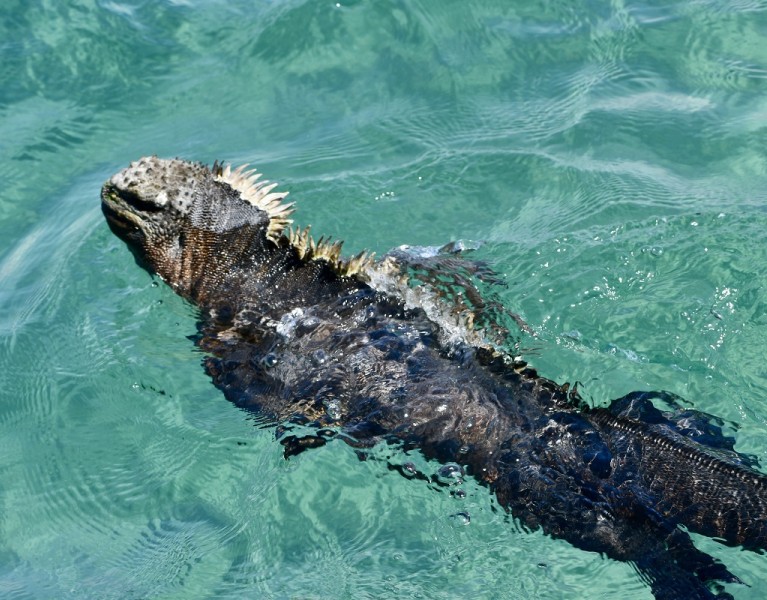
Isolated Galapagos Archipelago Offers Spectacular Adventure
Table of Contents [Show]
The biggest adventure you can take is to live the life of your dreams. ~ Oprah Winfrey
Like many people who adore wildlife in their natural habitats, I added the Galapagos Islands to my "must see list" decades ago. The logistics associated with an exotic, multi-island vacation made me second-guess its priority, even though it was on my dream vacation wish list. Far too many other spectacular places were considerably easier to reach and less pricey. I was willing to wait until the time was right for this unique adventure.
After experiencing Costa Rica’s plethora of birds, mammals, and marine life in diverse ecosystems and Magellanic penguins at the El Pedral Lodge outside Puerto Madryn, Argentina, I was ready to book a seven-night Galapagos Island experience.
Initially, the daunting task of picking the right tour was overwhelming. Exemplary reviews and my past experience with the Celebrity Cruises brand led to researching Celebrity’s itineraries and ship options. To avoid the crowds, my husband and I chose a sailing right before the Christmas holidays and opted for an Xpedition cruise that visited several locations in the Galapagos Archipelago.
From the moment we were picked up in the middle of the night at the Quito airport until the time we were dropped off at the Lima airport, we knew we'd made a wise choice. The local tour operators and the Xpedition crew made sure everything went as planned. This is indeed a rarity since unpredictable and disruptive events can occur when people travel to foreign countries.
The Odyssey Begins
Just a short distance from the Baltra Airport, our water journey began as we stepped aboard a rocking zodiac with our carry-on luggage. Rays of sunshine and salty air penetrated our skin as the small vessel zoomed toward the Xpedition.
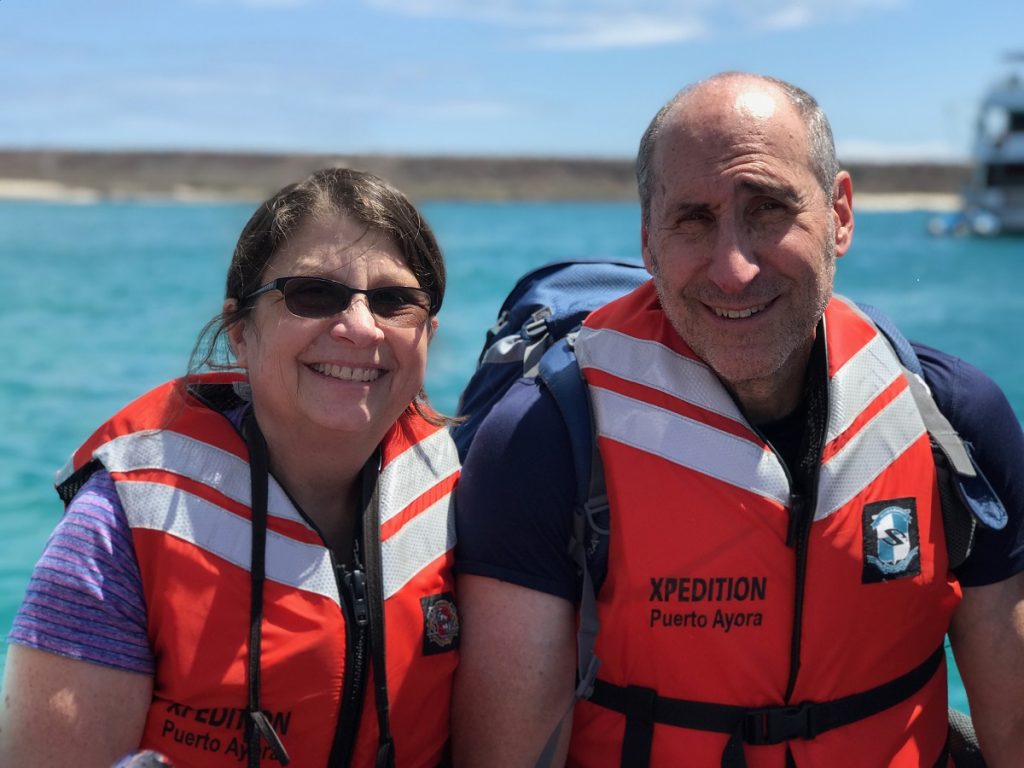
With a glass of champagne in hand, we were cheerfully escorted to our cabin. It didn’t take long to familiarize us with the vessel. The ship had only a handful of levels and a passenger capacity of 100 people. A small ship experience equated to an exemplary quality of service and outstanding food preparation.
Certified naturalists provided overviews of upcoming activities, possible encounters with wildlife, and whether we would have a wet or dry landing. To accommodate a wide range of interests and activity levels, we were given more than one choice for our morning and afternoon excursions. Weather permitting, we also had the opportunity to participate in deep water snorkeling on designated days. Each evening, we signed up for the following day's activities. While some of the wildlife could be viewed in multiple locations, all of the islands we visited had exceptional characteristics and unique terrain.
In most places around the world, wildlife sightings can be hit or miss. Patience and luck are often a huge factor. During our allotted times on the islands and in the water, we were able to see almost every species that was mentioned during the presentations. Frequently, our encounters were closer than everyone anticipated. Most of the animals didn’t exhibit any fear of their human visitors. Some were delighted to perform as cameras and videos clicked on and off. Others just sat motionless, unaffected by our looming presence. Our small group outings allowed for unobstructed views and an incredible opportunity to be amazingly close to a wide variety of species that flew overhead, scurried about on land, or swam in the sea.
As I scrolled through thousands of images, my memory captured a collage of wildlife on a diverse group of islands. I’ve culled out an assortment of these precious moments to highlight some of the extraordinary wildlife that inhabited Espanola Island, Floreana Island, Isabela Island, Fernandina Island, and Santa Cruz Island in December 2018.
Exploring Gardner Bay on Espanola Island
On the salt and pepper colored beaches of Espanola Island, a colony of sea lions rested peacefully while others welcomed our group with loud honking sounds as waves splashed along the shoreline. A few pelicans swooped overhead as marine iguanas soaked up the sunshine while resting on large rocks haphazardly placed on the pristine beach, as well as on the sand next to sea lions. They shared their space with red colored Sally Lightfoot crabs that inched along at their own pace. The iguanas were a few feet long and resembled mini dinosaurs.
A handful of colorful lava lizards darted across our path. They looked like midgets compared to the robust iguanas. Had it not been for our guide’s expertise, we would have quickly passed by a juvenile Galapagos hawk that was inconspicuously seated on a large rock. Perhaps, we wouldn't have been able to identify the pelicans flying gracefully over the sea or the mockingbirds walking on the sand.
From this moment forward, I appreciated our guides’ amazing abilities to point out flora and fauna.
Shallow Water Snorkeling at Gardner Bay
Before returning to the zodiac, we put on our wetsuits and snorkel gear and waded into the water. Swimming against the tide, we made our way to a solid mass referred to as Turtle Rock where colorful fish congregated near underwater rocky walls. Schools of surgeonfish and king angelfish could be distinguished in the semi-clear water.
While swimming back, we saw a stingray on the sandy ocean floor. When we reclaimed our possessions, mockingbirds and Darwin finches were strutting on the beach. One mockingbird was fixated on our plastic water bottle and our possessions. We scooped up our backpack and snorkeling gear, and the bird immediately pecked at a nearby bag.
Punta Suarez on Espanola Island
Back aboard the Xpedition, our fellow passengers were beaming. If the wildlife sightings were this amazing everyday, the trip would exceed our expectations. After a delicious lunch, everyone was eager for his or her afternoon excursion. Our trek was on rocky terrain where we passed a seaside blowhole where water rushed out in quick, periodic bursts like a geyser. While our attention was mainly focused on animals, this natural phenomenon caused our group to pause and mumble a few oohs and ahs as we took amazing photos.
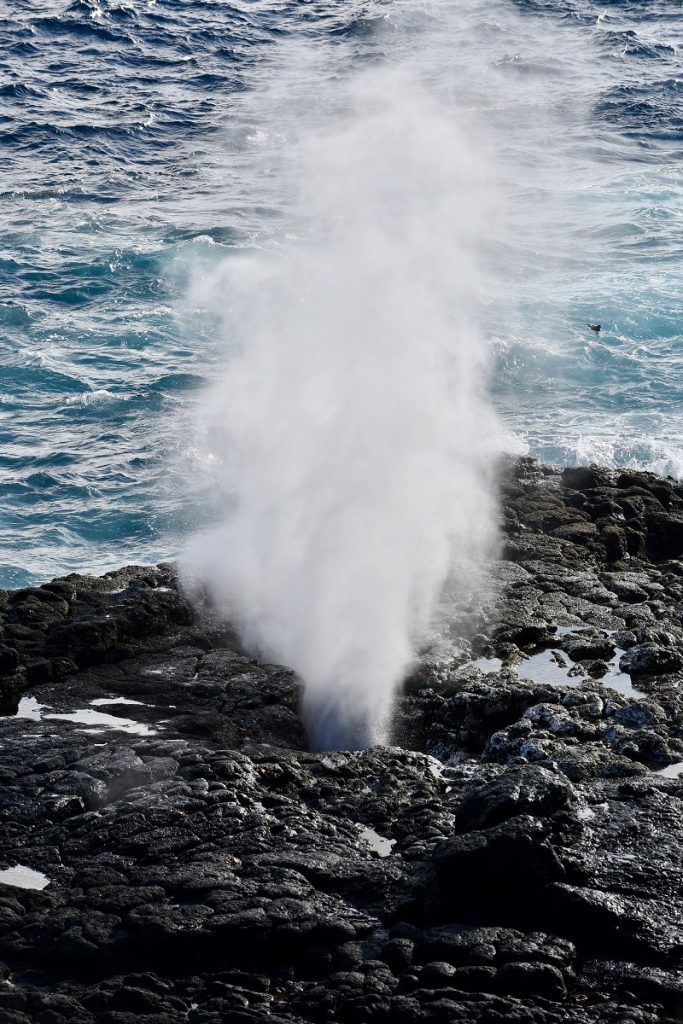
Once again, Sally Lightfoot crabs caught our attention. Their bright red color stood in sharp contrast to the grey rocks. Not knowing that we would see this species many more times, we continued to take an overabundance of photos.
We also came across more red and green marine iguanas, frequently referred to as Christmas Iguanas, and sea lions hanging out on the beach.
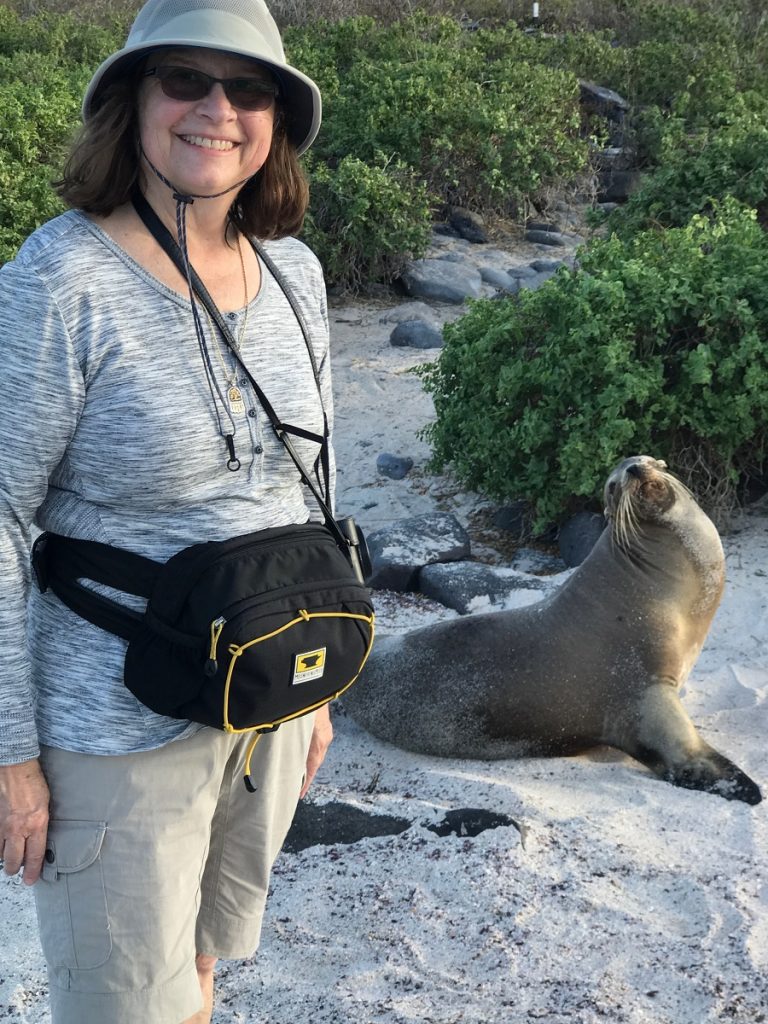
Blue-footed boobies, Nazca boobies, and waved albatross also enjoyed the rocky terrain near the coastline. Since I wore blue hiking boots, I was nicknamed "blue-footed booby" by some of our fellow passengers.
Waved Albatross Mating Ritual at Gardner Bay
In a field full of brown volcanic boulders, everyone was speechless as two waved albatross waddled on their large webbed feet toward one another. Their heads moved from side to side as they strutted forward. They used their notable yellow peaks to perform a mating ritual by hitting their beaks together and then stopping to make a notable sound. Usually, this ritual is performed at the beginning of the mating season. Our guide pointed out that these mature wave albatrosses were renewing or revitalizing their relationship before they departed. We were lucky to see this performance because the waved albatrosses inhabit this island only from April to December.
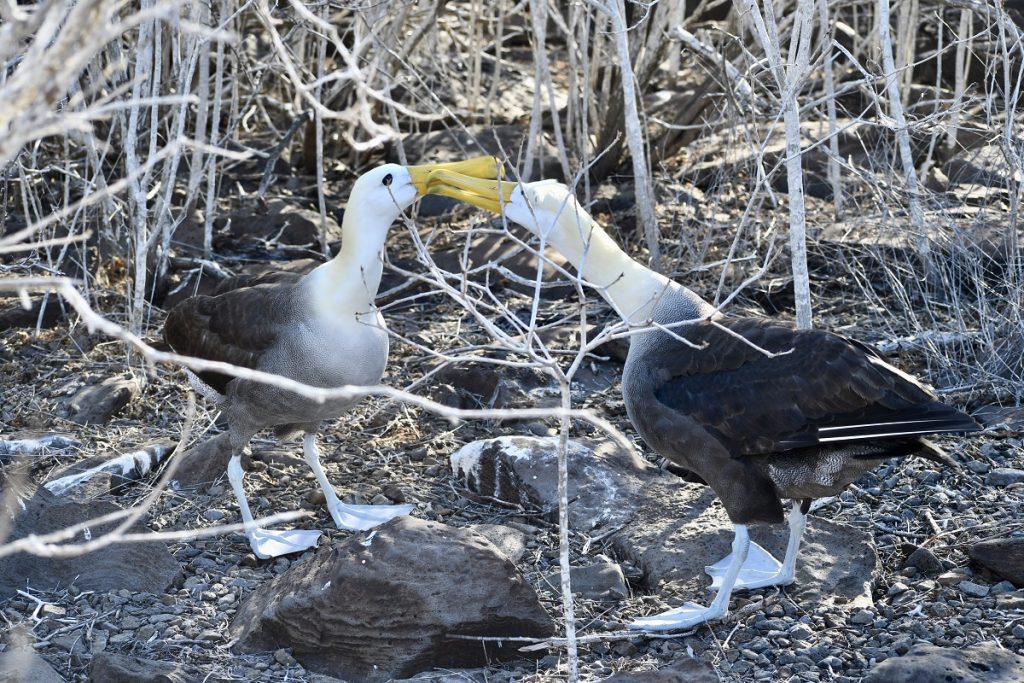
Punta Cormorant on Floreana Island
In advance of our landing at the olivine (green crystal) sand beach on Floreana Island, we were told that this type of beach is an ideal habitat for green sea turtles, but to expect to see the turtles elsewhere.
We walked by a brackish lagoon where flamingos were congregating in the distance. With only a few hundred on the island, we were happy to spot some. Before leaving the island, a small flock gracefully flew overhead. Our guide told us that these birds are not indigenous and migrated to the Galapagos Islands a very long time ago.
Occasionally, we saw yellow flowers blooming on a perennial flowering tree called a Jerusalem thorn. Mockingbirds congregated near this vegetation.
On another part of the island, we walked down a gravel path toward a secluded organic beach. At first, we didn’t see any wildlife. We just enjoyed the excellent view of the rhythmic ebb and flow of the sea touching the beach. Several green Pacific sea turtles were spotted a few yards in the water. For a short while, one swam close to the shoreline. His large shell was about all we could see. His head and legs were indistinguishable.
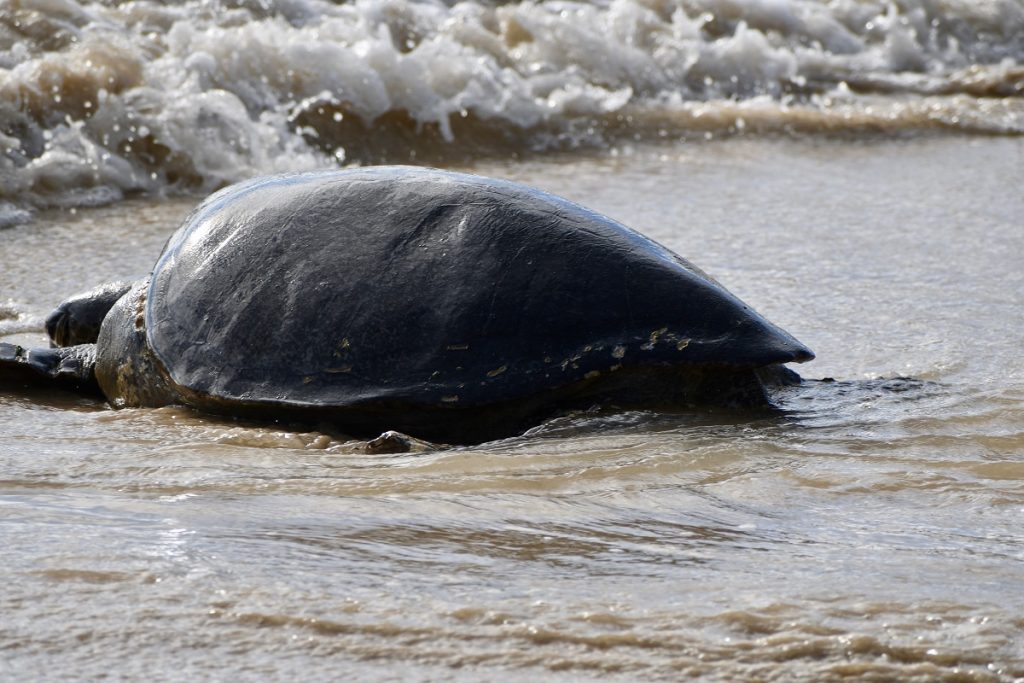
Our guide considered us fortunate since these turtles usually don’t make a presence during the daytime. We stood near the nesting site where the moms lay 60-120 eggs every year with only a survival rate of 10%.
Near our pickup point for the zodiac, a mother blue-footed booby nested with her baby on top of a hill. Until the mom decided to stand, we were unable to see her notable blue feet. The baby looked like a small pile of white feathers.
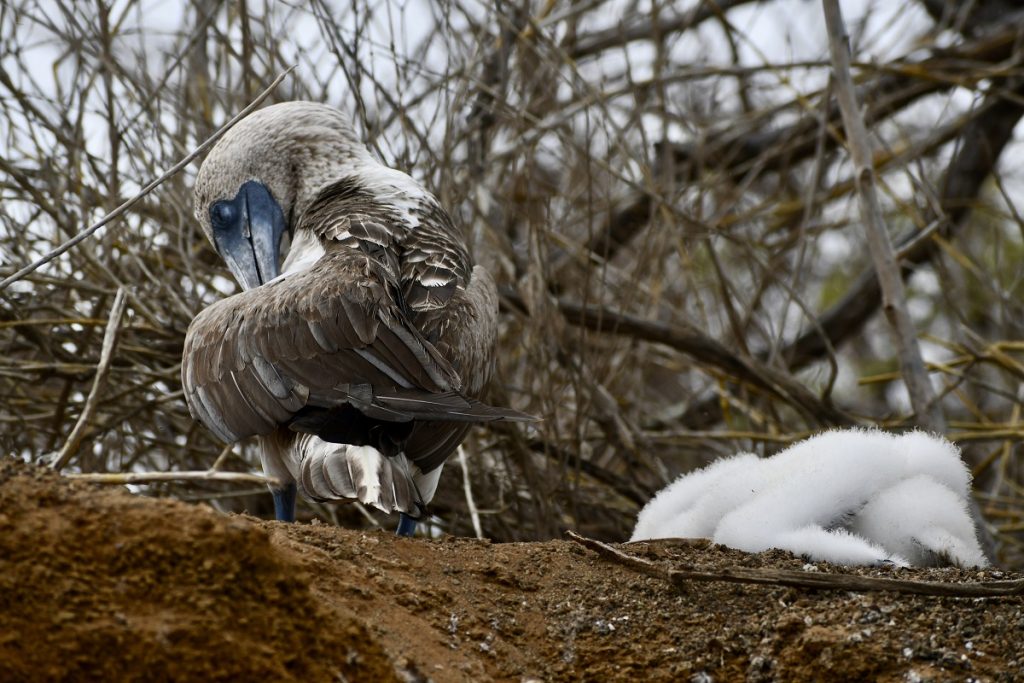
Deep Water Near Champion Island
After taking an abbreviated morning hike, we rode a zodiac back to the Xpedition to pick up our snorkeling gear. We were forewarned that the half hour journey to Champion Island might be a bit bumpy. The zodiac was no match for the excessive waves that made the craft bounce vigorously in the turbulent water. By the time our small group of ten passengers reached Champion Island, I was happy to enter the water.
The deep-water dive offered a more extensive selection of marine life. Our best viewing was near a shelf that ran close to the small rocky island. One has to be an accomplished swimmer to deal with the inconsistent water temperature and strong currents that fluctuated from area to area. While we did see an abundance of marine life, our viewing was partially obscured by the tide that caused the water to be murky in spots. While several species of fish were unidentifiable, we were able to pinpoint at least two kinds of starfish on the ocean floor and several schools of king angelfish. Ira spotted a white tipped shark in the distance.
Coastline Views of Marine Life Near Post Office Bay
Our zodiac hovered along the coastline so that we could gain another perspective of marine life. Crabs crawled in and out of crevices near the sea while red and green iguanas stood erect. Sea lions waddled from rock to rock and then dived into the water to play with their peers and youngsters.
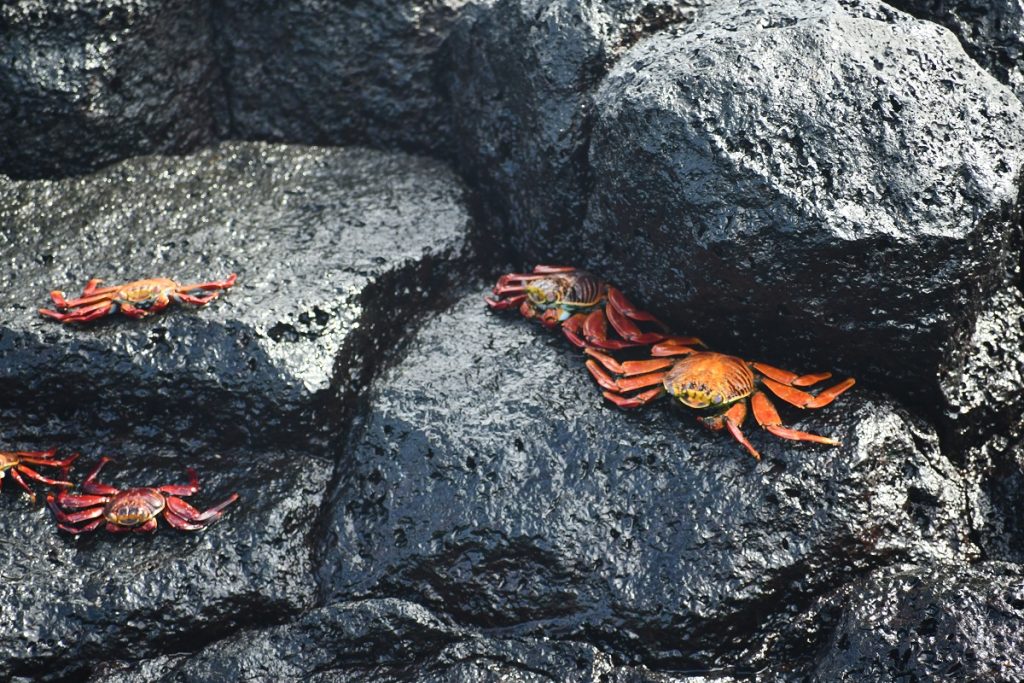
The zodiac drivers adeptly maneuvered the boats so that everyone had a chance to snap photos, but maintained a safe distance from the few sea turtles that could easily be mistaken for pieces of driftwood.
Isabela Island’s Rocky Black Lava Trail at Punta Moreno
Iguanas melded into the rugged lava landscape and created a continuous obstacle course. If I didn’t look down at my feet, I would have easily stepped on one or tripped on the uneven lava surface with sizeable cracks or fallen into a depressed area filled with water. The irregularly shaped lava rocks were both smooth and pointy. Some areas resembled layers of differently sized gray rope glued arbitrarily together.
Lava cactus and candelabra cactus jutted through the small cracks. Tiny lizards and colorful crabs were interspersed in the iguana population. An occasional penguin strutted by the others.
We stood near small ponds surrounded by greenery. A handful of pink flamingos reserved their own private space along the water’s edge. One was sleeping on one leg as our guide pointed to a mockingbird that was walking in front of us.
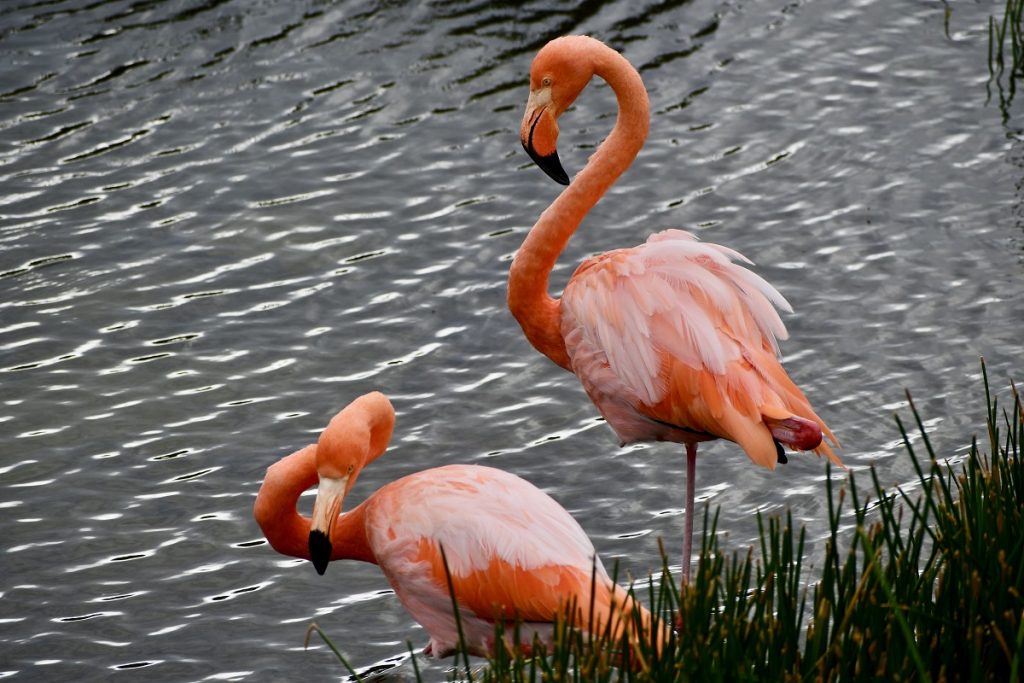
Surprisingly, patches of resilient greenery survived on this island that looked dramatically different from the other islands that we had seen. Most notable were the mangrove shrubs that thrived along the banks of the lagoons, Galapagos carpetweed, and succulent plants with white and yellow flowers.
Off the coast, pelicans dove into the water and then rested on jagged rocks while iguanas were content to swim in the aqua colored water and sunbathe on the rocky shoreline.
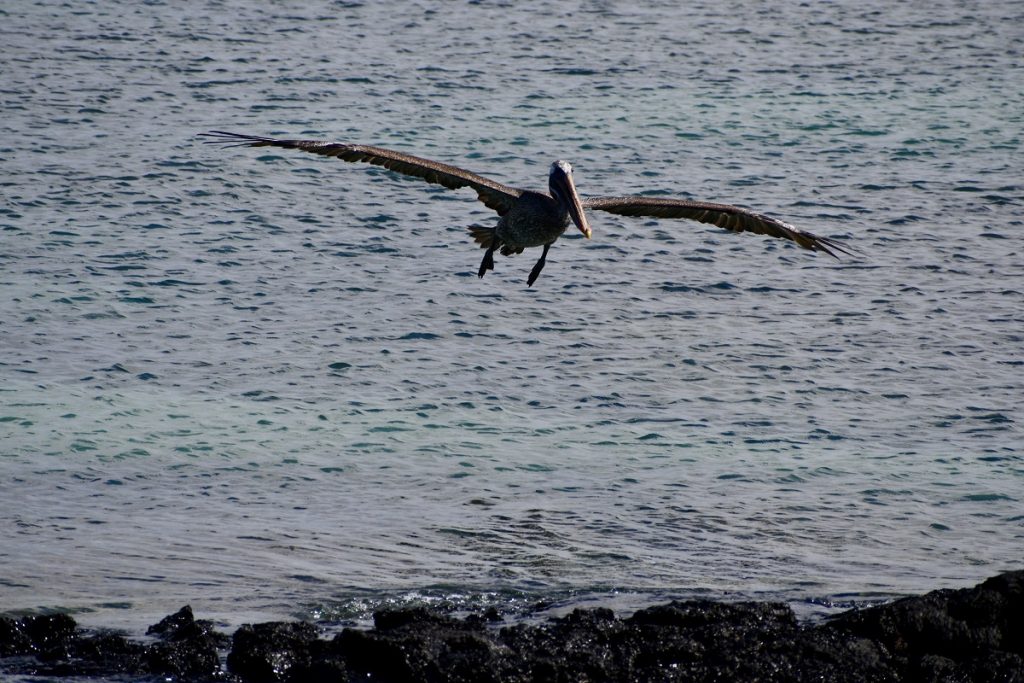
Urbina Bay on Isabela Island
A completely different terrain awaiting us when we disembarked off the zodiac at Urbina Bay. A variety of plants and short trees ran alongside a dirt path. Most beautiful were the Galapagos Cotton bushes filled with blooming yellow flowers.
Unlike the marine iguanas that were ubiquitous in other places, the orange colored land iguanas are territorial and have no interest in being close to their brethren. While dozens of marine iguanas are comfortable on top of one another, the land iguanas dig holes alongside the path at a considerable distance from one another.
Slow moving tortoises were occasionally sitting in the middle of the path. We had to saunter. One by one we skirted past the resting reptile to avoid scaring him. Even though their vision is limited, they would retract their head and legs when they sensed any movement nearby. I was surprised to learn that this species of tortoises are land dwellers and are unable to swim.
Our scheduled afternoon snorkel activity was curtailed by the dangerous tides. Getting back on the zodiacs was challenging for the less active passengers.
Fernandina Lava Fields and Sandy Areas
At our disembarkation point, a massive colony of oversized marine Iguanas camped out on a rocky area with an assortment of colorful shells, barnacles, and a handful of sea urchins scattered here and there.
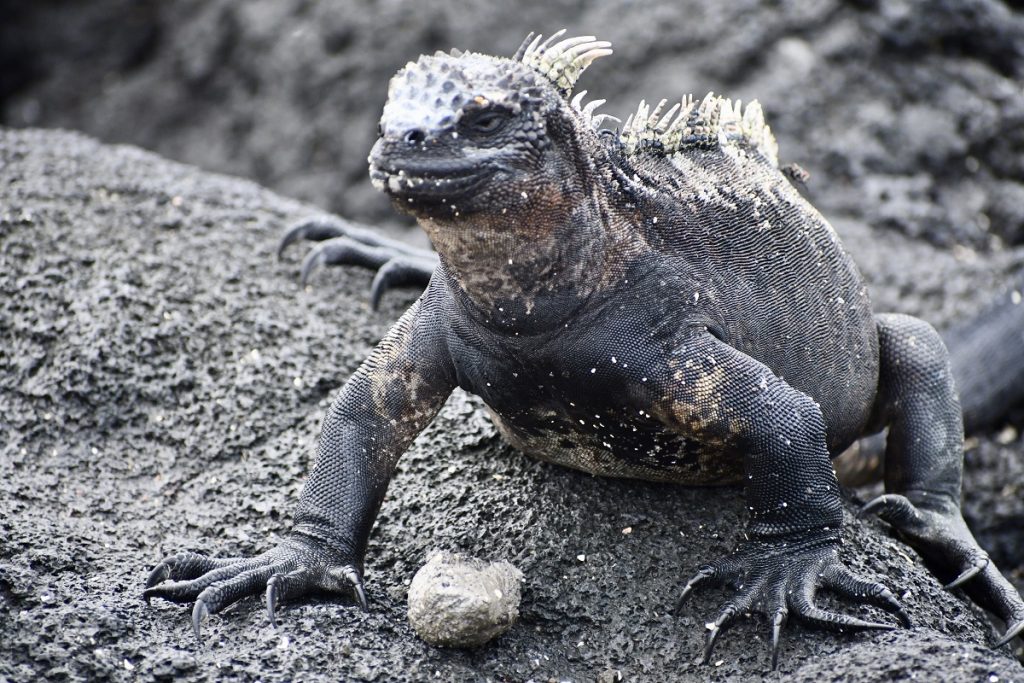
These less colorful iguanas were joined by a colony of sea lions that eagerly scampered in and out of the tide pools and continually performed for their human audience. We watched as a sea lion mom fetched food for her pup as crabs crawled without any reservations.
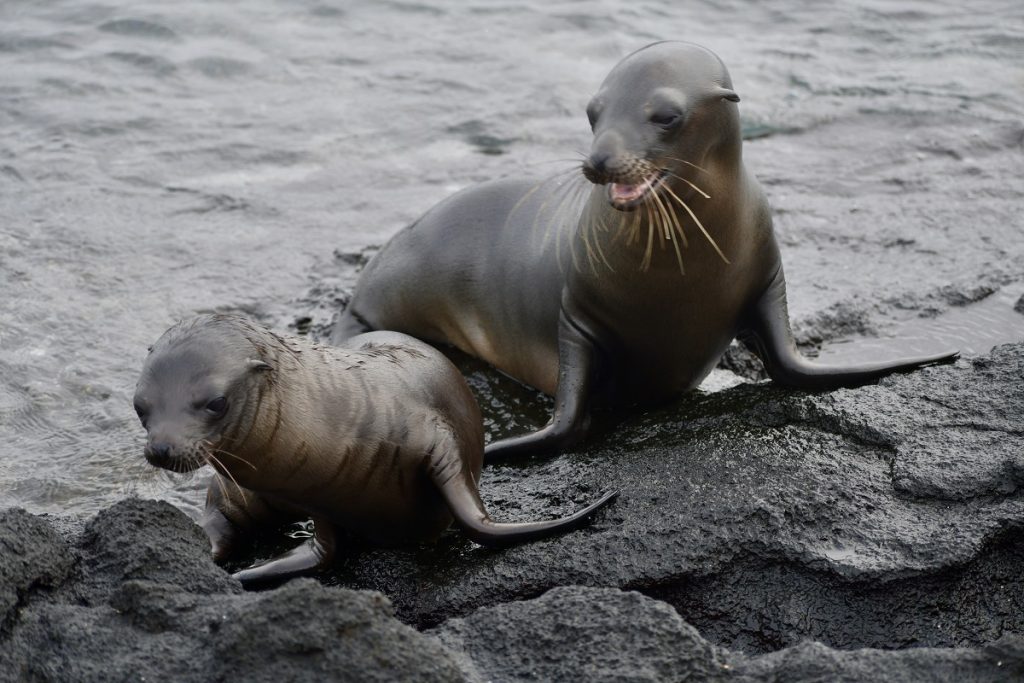
A Galapagos hawk stood guard at a nearby tree while flightless cormorants were off in the distance near waves crashing against small rock formations.
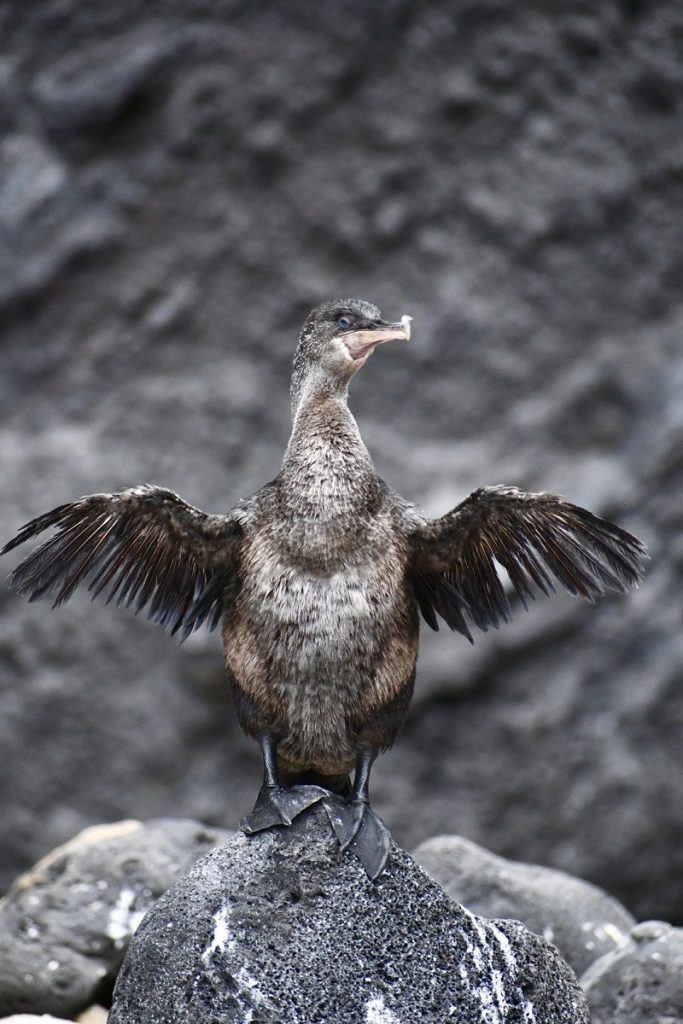
Memorable Snorkeling Encounter at Punta Vicente Roca Cove
The best part of the day was our final snorkeling excursion. After entering the water from the zodiac, we swam along the rocky shoreline until a designated point. Sea lions or possibly Galapagos fur seals approached us as if we were long lost friends. Pacific green sea turtles came uncomfortably close and then headed to the sandy ocean floor. My heart beat faster as I responded to this incredible interaction with marine life.
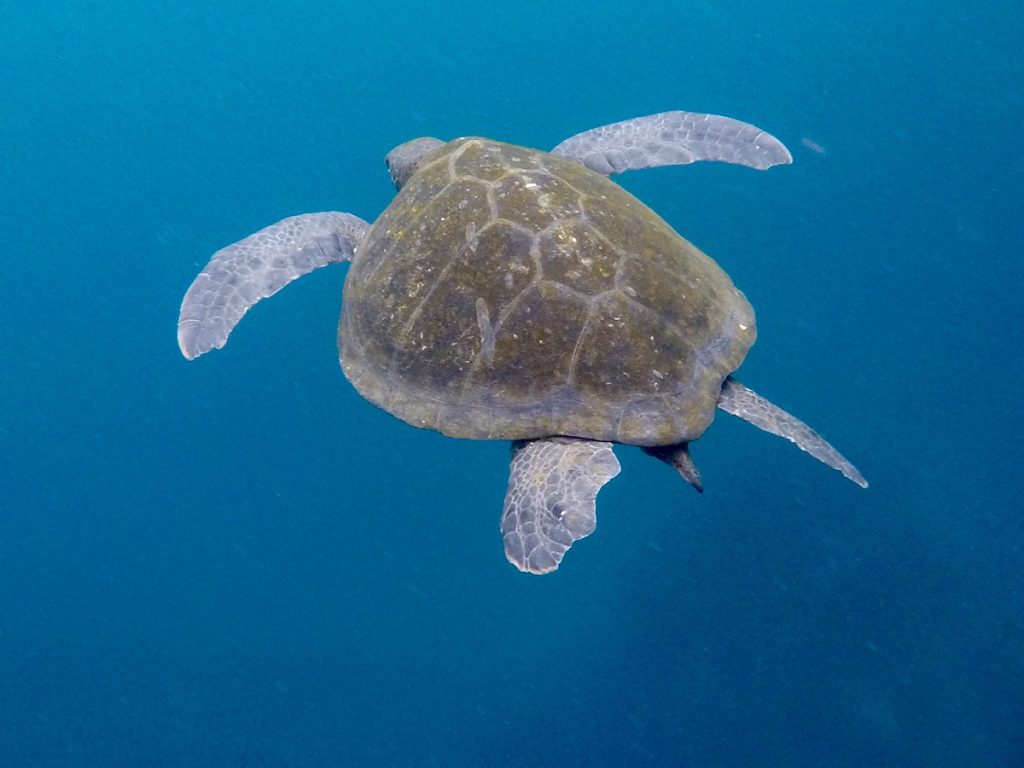
Schools of different types of fish were nearby throughout the adventure. An occasional penguin zoomed by without exhibiting any interest in our presence.
When our guide motioned for us to return to the zodiac, I wished that we could have stayed longer. I can’t wait until I can join marine life in their native environment again.
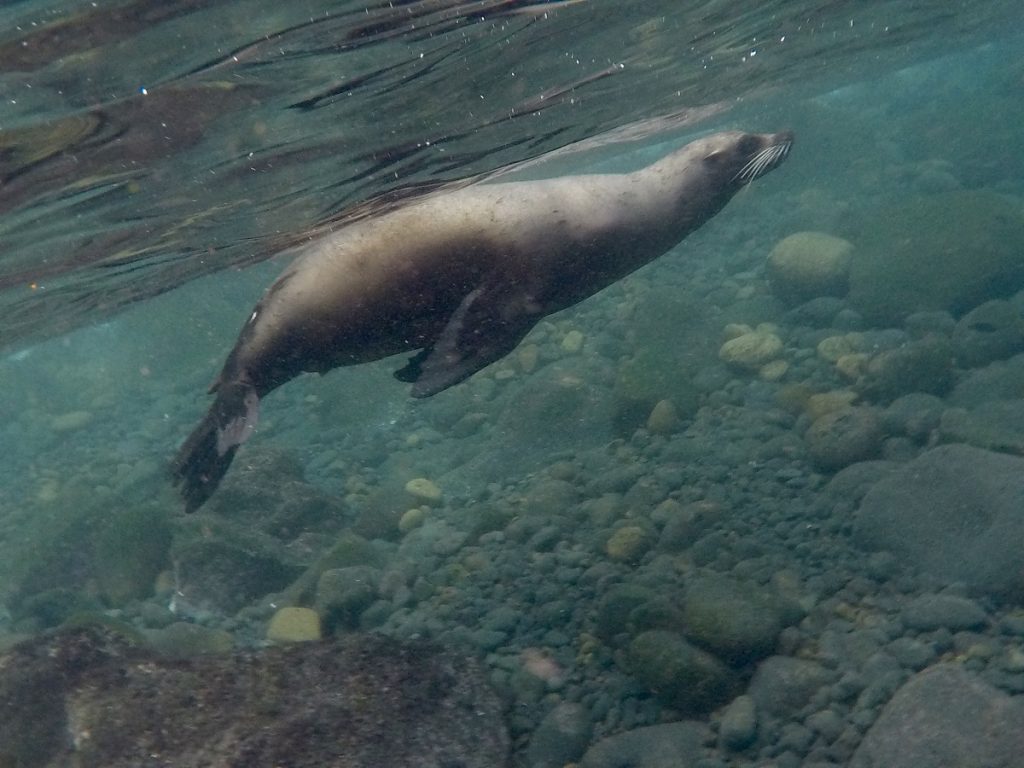
Zodiac Ride Near Punta Vincente Roca
In the afternoon, our zodiac returned to Punta Vincente Roca. This time, it hugged the shoreline of this steep-sided island with dozens of layers of colored sediment. Our guide introduced us to the Galapagos fur seal and golden eagle ray fish. These seals are part of the sea lion family and used to be hunted for their fur. With a limited population, we were glad that our photos captured this small colony.
Looking closely at the vertical rock formations that rose from the sea, we glanced up at stone ledges where a variety of birds—blue-footed boobies, noddy terns, flightless cormorants, and a hawk— sat comfortably above the crabs that crawled closer to the water’s edge.
Sea turtles distracted our attention from the shoreline as they popped up and down in the aqua colored water. They can relax on the sandy ocean floor for hours. We witnessed that during our earlier snorkeling excursion.
A small group of penguins rested on land and then waddled to the edge before jumping into the water. While marine iguanas lay huddled in groups, the other animals simply did their own thing.
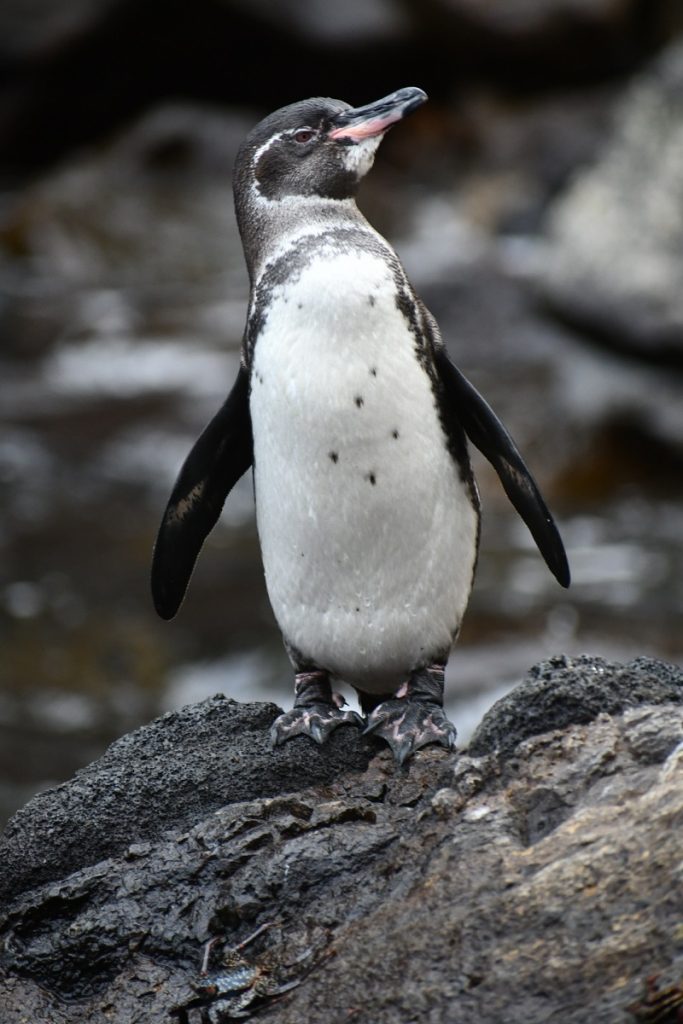
Back on the Xpedition, we drank champagne as we watched the sunset while crossing the equator.
South Plaza’s Crimson Landscape
South Plaza is just east of Santa Cruz. It is a small, narrow island frequently noted for its crimson, orange, yellow, and green carpet of succulent plants called sesuvium. In December, this color combination is similar to autumn colors found in a deciduous Northern Hemisphere forest. Towering over this picturesque carpet were intermittently spaced prickly pear cactus trees with yellow flowers.
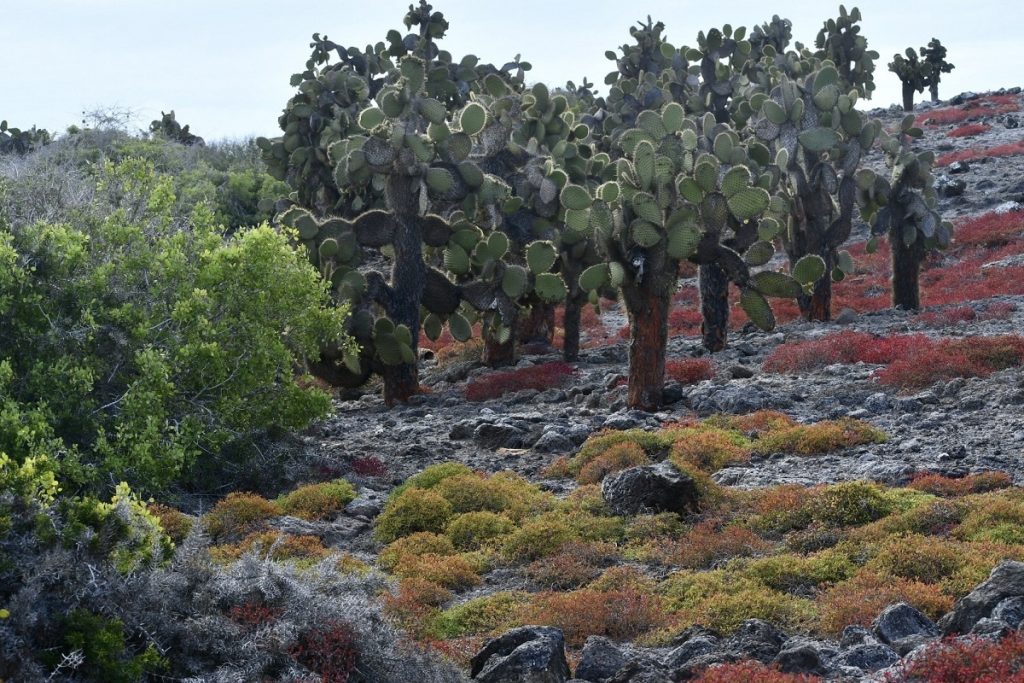
Walking on a sandy gravel path with a few boulders, we learned about the hybrid iguanas. This is the only known place in the world where marine iguanas have bred with land iguanas to produce a hybrid. With a limited amount of physical space, the two species are unable to create distinct territories so occasionally the two species mate.
The rare offspring look similar to a marine iguana but have long yellowish-white stripes on their neck. Remarkably these iguanas use their claws to climb cactus trees. Since the hybrid iguanas are a tiny percentage of the population and are sterile, our guide was only able to point out a couple hybrid iguanas. It was challenging to see without a zoom lens since both were several yards away.
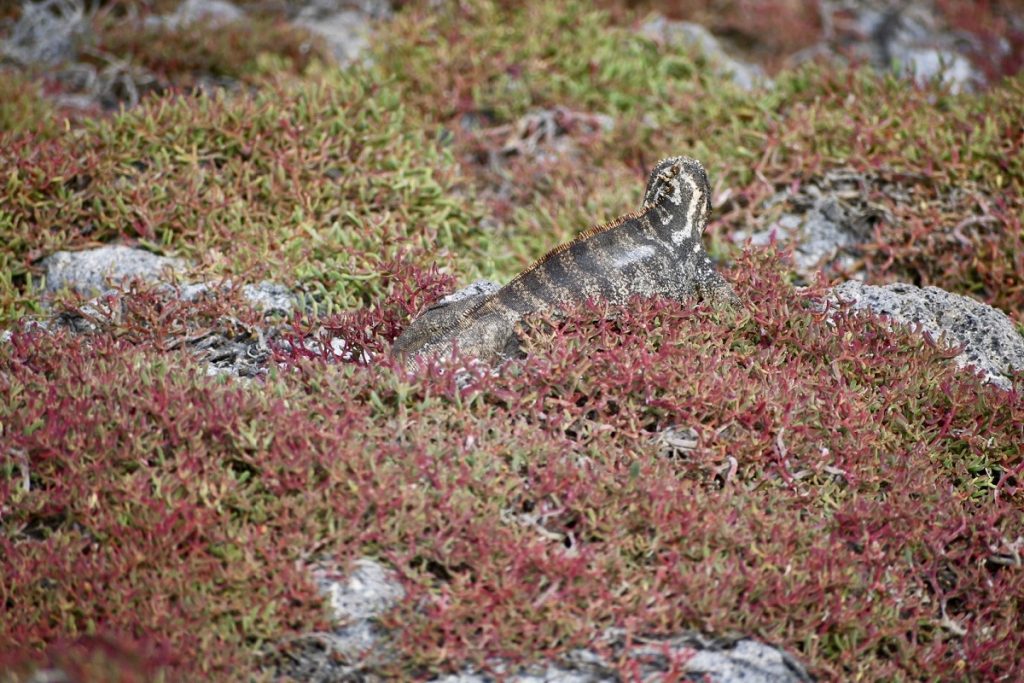
As waves crashed against the weathered coastline, swallow-tailed gulls, red-billed tropic birds, Nazca boobies, and blue-footed boobies graced the skies and landed in nests or on nearby cliffs. We had to watch where we stepped because smelly sea lion poop was everywhere.
While the sea lions provided entertainment throughout our two-hour walk, one iguana provided a star performance. On a rocky platform, this iguana stood on its hind legs and nibbled the edge of a cactus leaf while sea lions lurked in the background.
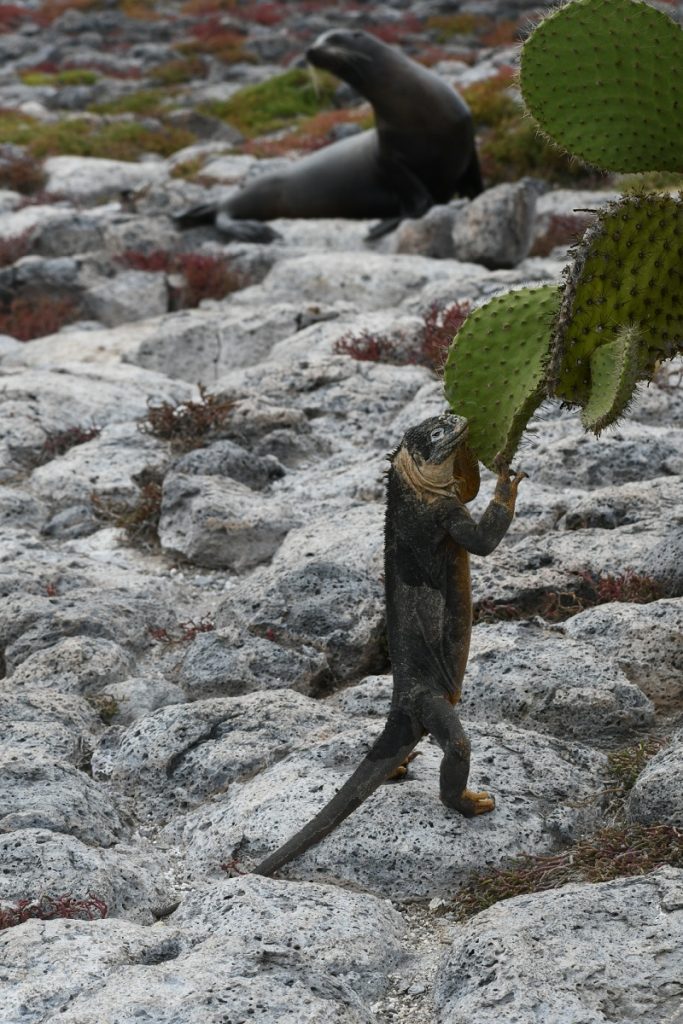
Barren Dragon Hill on Santa Cruz Island
In the afternoon, the Xpedition repositioned so that we could visit Dragon Hill on Santa Cruz. We walked onto a sandy beach surrounded by large chunks of black lava. A few marine iguanas waded along the shore. The beach was filled with seashells and the clear tide pools near the shoreline were filled with tiny beige colored fish.
Eventually, we walked on a black and orange colored lava surface bordered by some cactus with big long needles with yellow flowers and deciduous trees without leaves. There was little respite from the blistering heat as the path weaved upward toward a summit where we had remarkable views.
Along the way, the Galapagos land iguanas lay motionless as finches and mockingbirds skipped along on the arid terrain, and yellow warblers flew overhead. Goats, pigs, and dogs once threatened this indigenous population of iguanas until the Charles Darwin Foundation stepped in.
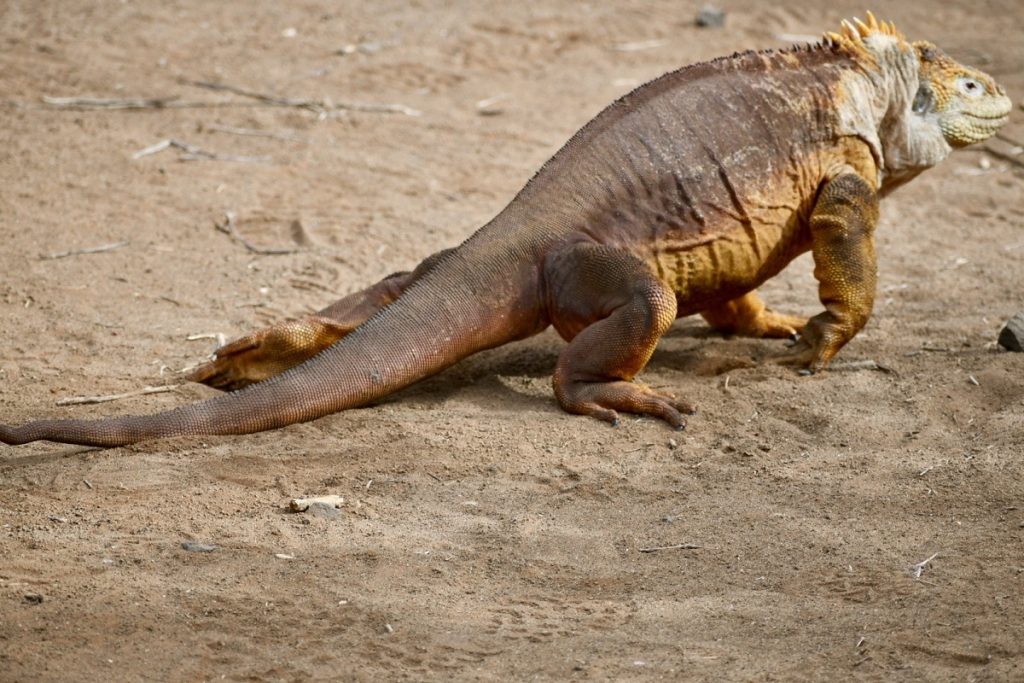
Galapagos Tortoise Breeding Center and Charles Darwin Research Center
The Charles Darwin Foundation for the Galapagos Islands has been working with the government of Ecuador since 1959 to ensure the conservation of the Galapagos Archipelago. In the morning, one of the naturalists led us through the breeding center where eggs from the islands of Pinzon, Santiago, and Santa Cruz are currently being incubated.
In 1965, the Charles Darwin Research Station started this successful breeding program to repopulate the giant tortoises on the Galapagos Islands. Today, the Galapagos National Park Directorate manages the program, which protects this species found only in the Galapagos and in the Aldabra Atoll in the Indian Ocean.
The giant tortoise population was severely depleted by sailors, pirates, whalers, and buccaneers who would take tortoises to be used as food on long voyages as well as by countless others who extracted the tortoise’s oil for lamps and used their shells for a variety of purposes. Outsiders wreaked havoc with the tortoise population by introducing pigs, rats, goat, and non-indigenous plants into the environment. It is estimated that only 10% of the original population lives on the archipelago today.
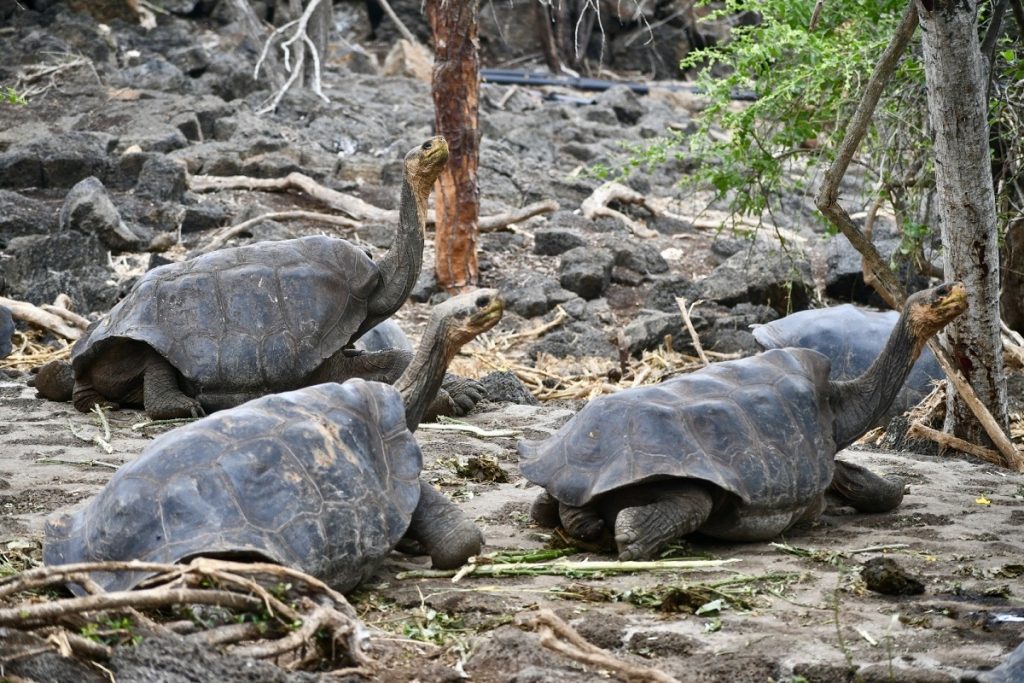
Walking from station to station, we observed newborns in incubators to mature tortoises in large pens surrounded by wire fencing. Each area provided the appropriate protection for different age groups. At the age of five, the tortoises are returned to their natural habitat so that they can be herbivores and seed dispensers. Surprisingly, these tortoises can go without eating and drinking water for many months.
Our group waited to enter a controlled environment where the remains of Lonesome George are on display. When George died in 2012, he was memorialized as the last Pinta Island tortoise. A diagram in the museum showed 12 different species of tortoises and four extinct species.
Inside the small museum, we viewed exhibits that explained the regional ocean currents, biological facts about native species, marine animal research, information about Charles Darwin, an overview of Galapagos Verde 2050, as well as the history of the islands.
After visiting the museum, we felt lucky to have seen the Galapagos penguins, the flightless cormorants, and the waved albatrosses, since all three of these native species are listed on the IUCN Red List of threatened species.
As hundreds of invasive species (plants, insects, mammals, and marine life) continue to affect the Galapagos Islands environment, the government of Ecuador is working to control these disruptive invaders. Successful efforts eliminated thousands of donkeys, feral pigs, and goats in several places. Galapagos Verde 2050 is designed to restore the damaged ecosystems and to generate sustainable agricultural processes.
Scalesia Reforestation Project
Before lunch, we drove about a half an hour out of town. Raindrops splashed onto the muddy ground as we planted trees at the Parque Nacional Galapagos. Most of the Xpedition passengers opted to participate in the Scalesia Reforestation Project. Each guest was handed a trowel and two tiny tree saplings to plant in pre-dug holes. This experience reminded us of our tree planting family experience in Israel decades ago. Both memories stand as continual reminders of the importance of planting trees to maintain a balanced ecosystem.
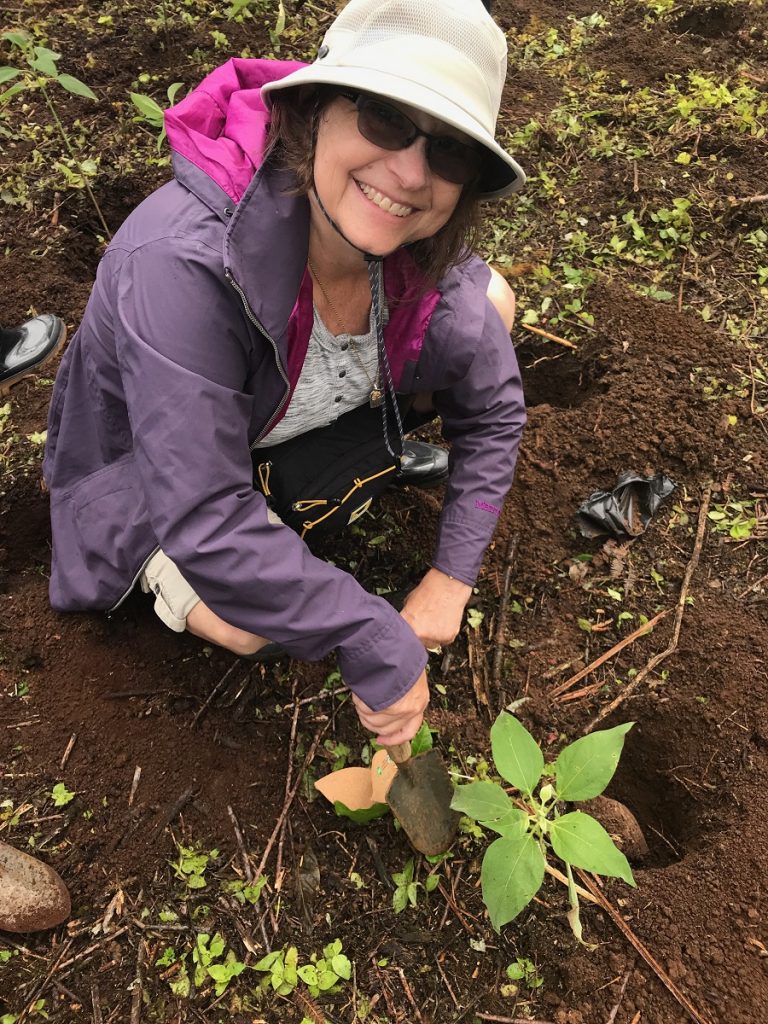
Last Chance for Wildlife
Our last chance to see giant sea tortoises was at Rancho El Manzanillo. In knee-high rubber boots, we followed our guide through grassy terrain dotted with small ponds covered with green algae. Ducks and little birds were not intimidated by the overabundance of tortoises that populated the grounds and the wetter areas.
Wildlife Lovers, Add the Galapagos to Your Must-Do List
As I waved good-bye to the Xpedition, my sense of well-being was at an all-time high. Each day of my journey had connected me with a previously unknown layer of Mother Nature’s handiwork. Learning about each unique ecosystem and its inhabitants created a greater sense of appreciation for life on Earth. My jaw frequently dropped wide open as I engaged in new encounters with unusual species. But then again, repeat exposures to wildlife were equally awe-inspiring. I can’t recall one moment when I didn’t wear a smile or wasn’t incredibly happy to be alive.
I’ve tried to vividly recount my remarkable adventure, but at times I struggled to find words that adequately described my memories, photos, and videos. I would have to agree with President Theodore Roosevelt who once said, “There are no words that can tell the hidden spirit of the wilderness, that can reveal its mystery, its melancholy, and its charm."
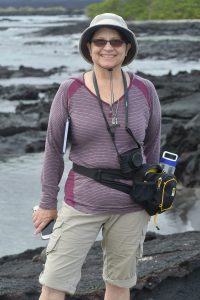 Sandy Bornstein, Galapagos Islands. Pictured in KÜHL TRISTA HOODY
Sandy Bornstein, Galapagos Islands. Pictured in KÜHL TRISTA HOODY
When Sandy Bornstein isn’t trekking in Colorado or writing, she's traveling with her husband Ira. After living as an international teacher in Bangalore, India, Sandy published an award-winning book, May This Be the Best Year of Your Life, as a resource for people contemplating an expat lifestyle and living outside their comfort zone. Among other things, Sandy writes about family, intergenerational, and active midlife adventures highlighting land and water experiences. All photos by The Traveling Bornsteins.


